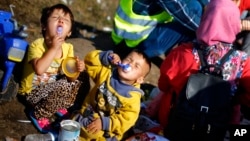The United Nations Children’s Fund is appealing for $14 million to assist increasing numbers of refugee and migrant children currently on the move in Europe.
According to UNICEF, an average of 19,000 children, many escaping conflicts in Syria, Iraq and Afghanistan, are arriving in the European Union every month, and one in every four of these children is an asylum seeker. Between January and July, it says 133,000 children have sought asylum in the European Union, an 80 percent increase over last year.
Since Hungary has closed its borders to refugees and migrants, thousands are transiting through Croatia to other countries in the EU. UNICEF representative Valentina Otmacic, who is monitoring the situation from the Opatovac refugee camp on the Serbian-Croatian border, says circumstances are bleak, particularly for migrant youth. describes conditions as people streamed across the border.
“I can see in front of me a queue of people arriving to the camp and I can see on the other side the buses also departing with people who have registered and have spent one or two days here and who are leaving to the border," she told VOA by phone. "I can see extremely harsh conditions for children on the move.”
Otmacic also said providing sufficient protection, food, shelter, and medical support for the children is a challenge that UNICEF is working with other agencies to overcome, ensuring that basic humanitarian needs are being met.
She said children, many of whom have been traveling for weeks, are exposed to very harsh conditions on a daily basis. The weather is getting colder and they lack warm clothing, and many have been surviving on canned and dry foods.
Otmacic also said many children are severely traumatized, recounting an event earlier this week, when a 9-year-old Afghan boy tried to kill himself.
UNICEF representative Otmacic said many families are being separated along the way, causing children to lose contact with parents and guardians. She warned the problem will only get bigger unless an international system of family tracing is rapidly established.








